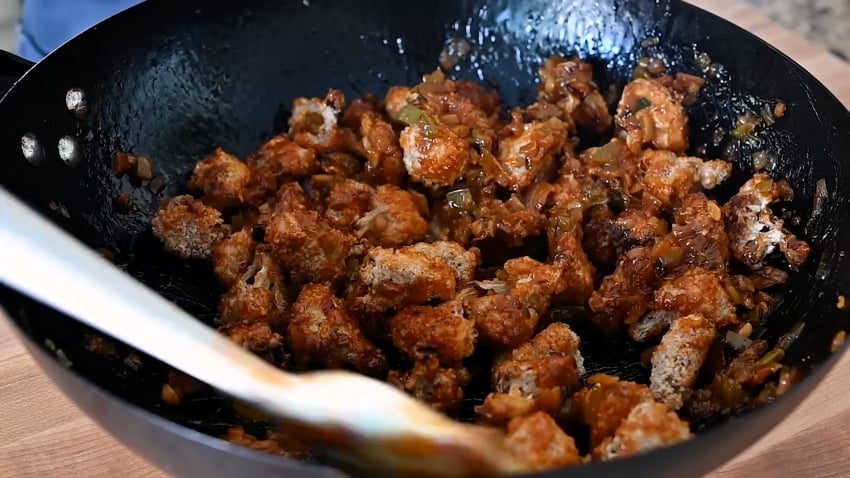From plantbasednews.org
Here are some smart strategies to overcome your veggie aversion for good
Some people fear snakes. Others fear spiders. But for many, nothing is scarier than a plate full of vegetables. In fact, a staggering 9 out of 10 Americans don’t eat enough vegetables, despite knowing how good they are for us. Whether it’s bad childhood memories of mushy peas or just not knowing how to make them taste good, the struggle is real. Luckily, Nisha Vora, the creator of Rainbow Plant Life, has advice that makes a lot of sense.
Vora, a Harvard-educated former corporate lawyer turned plant-based chef and content creator, recently shared a video breaking down why most people avoid vegetables – and how to change that. Her YouTube channel is known for accessible vegan recipes with a gourmet twist, and in this video, she blends practical tips with culinary know-how to help viewers finally enjoy their greens.
Here’s how she breaks down the obstacles that keep us and our loved ones from eating vegetables, and some strategies to overcome them.
Vegan chef Nisha Vora recommends to start by sneaking veggies into smoothies and soups that disguise their flavour - Media Credit: YouTube/Rainbow Plant Life1. Vegetables are scary
If you associate veggies with soggy side dishes and dinner table stand-offs, you’re not alone. “They can kind of seem like a villain in a low-budget horror film,” Vora says.
She recommends starting with stealth. Add leafy greens to smoothies (“I don’t even notice the taste or texture difference,” she says), sneak roasted beets into hummus, or blend spinach into your favourite pesto. You’ll get the nutrients without the drama.
She also loves blended soups, like her creamy cauliflower soup, which has an entire head of cauliflower in it but you would never suspect it “because it is so creamy and luxurious.”
2. They’re too much to chew
Raw kale and cabbage can feel like a workout for your jaw. Vora suggests slicing vegetables into thin ribbons or small bites to make them easier to eat. For kale, “strip out that tough middle rib, roll up the leaves and slice them super thinly,” then massage them with olive oil, lemon juice, and salt to tenderize.
Cooking also helps. Sautéing shredded cabbage or wilting greens into soups and stews can turn rough textures soft and silky.
3. They taste bad
Boiled broccoli is nobody’s idea of a good time. “A steamed Brussels sprout is kind of like a sad miniature cabbage,” Vora jokes. But roasting transforms flavour through the Maillard reaction, where heat brings out natural sugars, amino acids, and umami depth.
She roasts at 425°F for golden, crispy edges. You can also char veggies in a hot pan. “With just a little bit of oil and seven minutes, you can transform raw, crunchy, cruciferous broccoli into deliciously charred broccoli.”
4. They’re not crispy enough

Crunch matters. “Crispiness is our favourite food texture in the United States,” says Vora, citing Stanford research.
She suggests oven-roasting mushrooms for a crispy soup topper, making kale chips, or trying Gobi Manchurian – deep-fried or baked cauliflower tossed in stir fry sauce. Even her maple-roasted squash gets “kind of crisp and chewy” in the oven.
5. They spoil too fast
Nothing kills motivation like a fridge full of wilted greens. To combat this, Vora preps kale right after shopping: “Strip out that tough rib in the middle, and then tear the leaves or slice them…wash and dry them, and then place them in a reusable bag.” She says this trick alone boosted her kale consumption by “about 37.5 percent.”
She also recommends pickling (with vinegar, water, salt, and sugar) for long-lasting zing, and keeping frozen vegetables on hand for quick stir-fries and soups – no thawing needed.
6. They take too long to prep
No one wants to spend their evening shredding cabbage. That’s why Vora advocates for weekend meal prep. “Take 30 minutes or so to chop and store your vegetables,” she says. It makes weeknight cooking feel doable.
Tools help too. Vora swears by a sharp chef’s knife, a mandoline for thin slicing, and a food processor: “If I try to shred two pounds of Brussels sprouts by hand, it’s gonna take me approximately 84 years.” But with the slicing disc on her food processor, it takes her two minutes.
7. They feel like a chore
This might be the biggest shift of all: stop treating vegetables like punishment. “What would it look like to eat vegetables not because they’re good for me, but because they are truly delicious?” Vora asks.
She encourages people to get inspired by vegetable-forward recipes online or in cookbooks, and social media accounts that make cooking vegetables fun. Her own collection, Big Vegan Flavor, includes entire chapters titled “Big-Personality Salads” and “Vegetables Are the Main Event.”
8. You don’t love salad (yet)
Vora’s final tip is to reframe how you think about salads. “I know that seems like a tall order,” she says, but she promises it’s possible. She even made a separate video about learning to love them.
With so many ways to roast, blend, pickle, and sauce your way to veggie bliss, eating more plants doesn’t have to be a struggle. It might even be fun.
Vora assembled all of these tips and recipes into a PDF guide that you can download here. Find more of her vegan recipes and lifestyle videos on her YouTube channel, Rainbow Plant Life.
https://plantbasednews.org/lifestyle/food/how-to-eat-more-vegetables-if-you-hate-them/

No comments:
Post a Comment